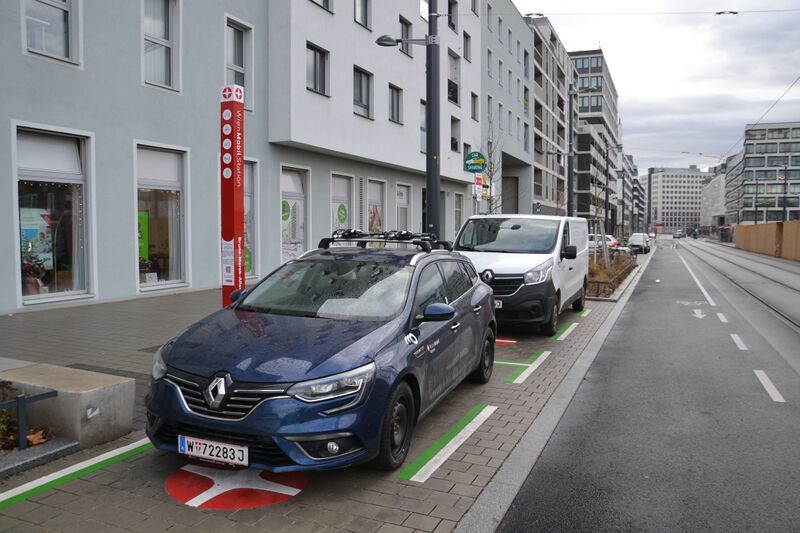<ul><li>",9million" can not be assigned to a declared number type with value 1.</li> <!--br--><li>",3million" can not be assigned to a declared number type with value 2.</li> <!--br--><li>"(statista.com)" can not be assigned to a declared number type with value 2100.</li></ul>
Mobility Point Bruno Marek Allee
Typology
urban neighbourhood hub - small (two shared modes, <10 vehicles)
Short Description
housing-based, decentralized hub, with carsharing, bikesharing and PT nearby
USP
Mobility Hub in new urban area, with an audience with a very high sharing affinity . Car sharing vehicles are located in public space, other vehicles (bikes, cargo bikes,..) are located on a semi- private location.
Station is owned by Wiener Linien (public transport operator) but operated by MO.Point (private sharing operator for all kind of vehicles)
Location
Nordbahnhofviertel
Vienna, Austria
Loading map...
{"minzoom":false,"maxzoom":false,"mappingservice":"leaflet","width":"auto","height":"350px","centre":false,"title":"","label":"","icon":"","lines":[],"polygons":[],"circles":[],"rectangles":[],"copycoords":false,"static":false,"zoom":17,"defzoom":14,"layers":["oepnvkarte"],"image layers":[],"overlays":[],"resizable":false,"fullscreen":false,"scrollwheelzoom":true,"cluster":false,"clustermaxzoom":20,"clusterzoomonclick":true,"clustermaxradius":80,"clusterspiderfy":true,"geojson":"","clicktarget":"","imageLayers":[],"locations":[{"text":"","title":"","link":"","lat":48.22411,"lon":16.39338,"icon":""}],"imageoverlays":null}
Physical Integration
Level 0
(target: Level 2)Definition 0 (No physical integration): One shared transport mode, not at walking distance to public transport, no integration between the modes. No universal design criteria are considered
scattered, also between public and private spaces, visual station mark, ground signage
Car Sharing in public space- good visible from the Tram Station. Bike Sharing and other vehicles are in a semi public area. Signs and maps show the location of vehicles at the station
Digital Integration
Level 0
(target: Level 2)Definition 0 (No digital integration): No digital integration of shared and public transport mode options offered at the hub. There are separate services and platforms for each mode. No universal design criteria are required
integration through MO.Point App & WienMobil App
Reservation and booking only through the MO.Point App (App of Operator)
Democratic Integration
Level 0
(target: Level 3)Definition 0 (No involvement): No involvement or consideration of stakeholder interests and user needs.
Information about vehicles in printed and digital version. Information in word and pictogramms- easy to understand the usage. Intuitive reservation and booking process.
24h service hotline available
Spatial facilities
Bike parking, PT stop (quite distant),
Neighbourhood Characteristics
brownfield development in central location, middle - high income inhabitants in surrounding area, 49 - 271 cars / 1000 inhabitants
Governance
Inhabitants
City:
19 million in 2021
(Prognosis: 23 million in 2100 (statista.com))
Local Governance
- parliament president since 2018: Ernst Woller
- governance with 7 departments; each divided into multiple municipal authorities
Local Administration:
- Mayor: Michael Ludwig (SPÖ)
- Deputy Mayor and Deputy Governor, Executive City Councillor for Housing, Housing Construction, Urban Renewal and Women's Issues: Kathrin Gaal
- Deputy Mayor and Deputy Governor, Executive City Councillor for Education, Youth, Integration and Transparency: Christoph Wiederkehr
- Executive City Councillor of Finance, Business, Labour, International Affairs and Vienna Public Utilities: Peter Hanke
- Executive City Councillor for Social Affairs, Public Health and Sports: Peter Hacker
- Executive City Councillor for Innovation, Urban Planning and Mobility: Ulli Sima
- Executive City Councillor for Climate, Environment, Democracy and Personnel: Jürgen Czernohorszky
- Executive City Councillor for Cultural Affairs and Science: Veronica Kaup-Hasler
Regional Governance
Vienna Provincial Government (100 members)
+ Vienna Provincial Parliament (Governor + currently 12 City Councilors)
Regional Administration:
By the Office of the Provincial Government under the direction of the Head of the Office of the Provincial Government
National Governance
Austrian Federal Government
